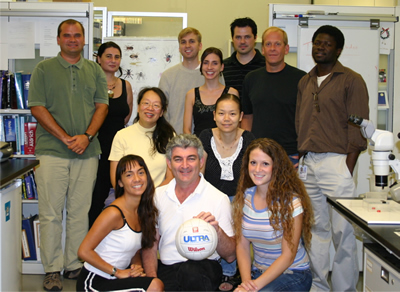| |
| |
| Kenton J. Swartz, Ph.D., Senior Investigator |
 |
Dr. Swartz received his B.S. degree in Chemistry and Biology in 1986 from Eastern Mennonite College. In 1992 he received his Ph.D. in Neurobiology from Harvard University where he worked with Bruce Bean studying the regulation of voltage-gated calcium channels by G-proteins and protein kinases. He did postdoctoral training with Roderick MacKinnon at Harvard Medical School, where he began isolating and studying toxins that interact with voltage-activated potassium channels. Dr. Swartz joined NINDS as an Investigator in 1997 and was promoted to Senior Investigator in 2003. His laboratory is using biochemical, molecular biological and biophysical techniques to investigate the structure of voltage-activated ion channels and to explore the molecular mechanics by which these channels gate.
|

|
Staff:

- Maria Isabel Bahamonde Santos, Ph.D., Postdoctoral Fellow bahamonm@mail.nih.gov.
- Frank Bosmans, Ph.D., Postdoctoral Fellow Bosmansf@ninds.nih.gov
- Tsg-Hui (Helena) Chang, M.Sc, Research Assistant ChangT@ninds.nih.gov
- Jeet Kalia, Ph.D., Postdoctoral Fellow kaliaj@ninds.nih.gov
- Dmitriy V Krepkiy, Ph.D., Postdoctoral Fellow krepkiyd@ninds.nih.gov
- Mufeng Li, Ph.D., Postdoctoral Fellow limuf@ninds.nih.gov
- Mirela Milescu, Ph.D., Postdoctoral Fellow milescum@ninds.nih.gov
- Margaret Parker, B.S., Post baccalaureate Fellow parkerm2@ninds.nih.gov
- Shai Silberberg, Ph.D., Adjunct Investigator silberbs@ninds.nih.gov
- Jaime Smith, Ph.D., Postdoctoral Fellow smithjam@ninds.nih.gov
Research Interests:
Voltage-gated ion channels are expressed in many cells types and are important for an array of physiological processes, including the generation and processing of electrical signals in the nervous system, regulation of heart contraction and secretion of hormones. The role of these channels in electrical signaling is particularly important because they open and close in response to changes in membrane voltage. For example, action potentials result from the orchestrated action of voltage-gated sodium and potassium channels, and voltage-gated calcium channels convert electrical to chemical signals in the process of excitation-secretion coupling.
The three main classes of voltage-gated ion channels belong to a common family of membrane proteins constructed from two types of domains: a central pore domain where the conduction pathways for potassium, sodium or calcium ions reside, and four surrounding voltage-sensing domains. A major focus of the lab is to explore the structure of the voltage-sensing domains in voltage-gated potassium (Kv) channels and to define how and where the voltage-sensors interact with the gate region of the pore domain.
A complementary aim is to study protein toxins that interact with voltage-gated ion channels. Our work with a class of toxins that we refer to as gating modifier toxins has begun to reveal new mechanisms by which channel-interacting proteins modify activity and to shed light on several fundamental questions concerning the process of voltage-sensing. Since many drugs affecting the nervous system derive their efficacy by modulating the gating of voltage-gated channels, we continue to search for new molecules that interact with these channels and to study the molecular basis for their actions.
|
Selected Recent Publications:
Li, M., Chang, T-H., Silberberg, S.D. and Swartz, K.J. (2008) Gating the pore of P2X receptor channels., Nature Neuroscience 11, 883-887.
Full Text/Abstract
Bosmans, F., Martin-Eauclaire, M.F. and Swartz, K.J. (2008) Deconstructing voltage sensor function and pharmacology in sodium channels, Nature 456, 202-208.
Full Text/Abstract
Swartz, K.J. (2008) Sensing voltage across lipid membranes, Nature 456, 891-897.
Full Text/Abstract
Silberberg, S.D, Li, M. and Swartz, K.J. (2007) Ivermectin interaction with transmembrane helices reveals widespread rearrangements during opening of P2X receptor channels, Neuron 54, 263-274.
Full Text/Abstract
Alabi, A.A., Bahamonde, M.I., Jung, H.J., Kim, J.I., and Swartz, K.J. (2007) Portability of paddle motif function and pharmacology in voltage sensors, Nature 450, 370-375.
Full Text/Abstract
Milescu, M., Vobecky, J., Roh, S.H., Kim, S.H., Jung, H.J., Kim, J.I. and Swartz, K.J. (2007) Tarantula toxins interact with voltage sensors within lipid membranes, J Gen Physiol 130, 497-511.
Full Text/Abstract
Phillips, L.R., Milescu, M., Li-Smerin, Y., Mindell, J., Kim, J.I. and Swartz, K.J. (2005) Voltage-sensor activation with a tarantula toxin as cargo, Nature 436, 857-860.
Full Text/Abstract
All Selected Publications
Contact Information:
Dr. Kenton J. Swartz
Molecular Physiology and Biophysics Section, NINDS
Porter Neuroscience Research Center
Building 35, Room 3B-215
35 Convent Drive, MSC 3701
Bethesda, MD 20892-3701
Telephone: (301) 435-5652 (office),
(301) 435-5653 (laboratory),
(301) 435-5666 (fax)
Email: swartzk@ninds.nih.gov
|
|















